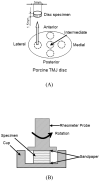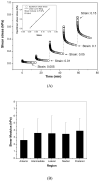Viscoelastic shear properties of porcine temporomandibular joint disc
- PMID: 25865544
- PMCID: PMC4747254
- DOI: 10.1111/ocr.12088
Viscoelastic shear properties of porcine temporomandibular joint disc
Abstract
Objectives: To investigate the intrinsic viscoelastic shear properties in porcine TMJ discs.
Materials and methods: Twelve fresh porcine TMJ discs from young adult pigs (6-8 months) were used. Cylindrical samples (5 mm diameter) with uniform thickness (~1.2 mm) were prepared from five regions of the TMJ disc. Torsional shear tests were performed under 10% compressive strain. Dynamic shear was applied in two methods: 1) a frequency sweep test over the frequency range of 0.1-10 rad/s with a constant shear strain amplitude of 0.05 rad and 2) a strain sweep test over the range of 0.005-0.15 rad at a constant frequency of 10 rad/s. Transient stress relaxation tests were also performed to determine the equilibrium shear properties.
Results: As the frequency increased in the frequency sweep test, the dynamic shear complex modulus increased, with values ranging from 7 to 17 kPa. The phase angle, ranging from 11 to 15 degrees, displayed no pattern of regional variation as the frequency increased. The dynamic shear modulus decreased as the shear strain increased. The equilibrium shear modulus had values ranging from 2.6 to 4 kPa. The posterior region had significantly higher values for dynamic shear modulus than those in the anterior region, while no significant regional difference was found for equilibrium shear modulus.
Conclusion: Our results suggest that the intrinsic region-dependent viscoelastic shear characteristics of TMJ disc may play a crucial role in determining the local strain of the TMJ disc under mechanical loading.
Keywords: dynamic mechanical testing; porcine animal model; shear modulus; temporomandibular joint disc.
© 2015 John Wiley & Sons A/S. Published by John Wiley & Sons Ltd.
Figures





Similar articles
-
The region-dependent dynamic properties of porcine temporomandibular joint disc under unconfined compression.J Biomech. 2013 Feb 22;46(4):845-8. doi: 10.1016/j.jbiomech.2012.11.035. Epub 2012 Dec 20. J Biomech. 2013. PMID: 23261240
-
Viscoelastic properties of the central region of porcine temporomandibular joint disc in shear stress-relaxation.J Biomech. 2019 Aug 27;93:126-131. doi: 10.1016/j.jbiomech.2019.06.023. Epub 2019 Jul 2. J Biomech. 2019. PMID: 31301763
-
Shear properties of the temporomandibular joint disc in relation to compressive and shear strain.J Dent Res. 2004 Jun;83(6):476-9. doi: 10.1177/154405910408300608. J Dent Res. 2004. PMID: 15153455
-
Biomechanical behavior of the temporomandibular joint disc.Crit Rev Oral Biol Med. 2003;14(2):138-50. doi: 10.1177/154411130301400207. Crit Rev Oral Biol Med. 2003. PMID: 12764076 Review.
-
Is the nucleus pulposus a solid or a fluid? Mechanical behaviors of the nucleus pulposus of the human intervertebral disc.Spine (Phila Pa 1976). 1996 May 15;21(10):1174-84. doi: 10.1097/00007632-199605150-00009. Spine (Phila Pa 1976). 1996. PMID: 8727192 Review.
Cited by
-
Characterizing the Baseline Regional Biphasic Mechanical Properties of Cervical Intervertebral Discs.Ann Biomed Eng. 2025 Sep;53(9):2333-2345. doi: 10.1007/s10439-025-03759-2. Epub 2025 May 21. Ann Biomed Eng. 2025. PMID: 40399746 Free PMC article.
-
Human adipose-derived stromal/stem cells expressing doublecortin improve cartilage repair in rabbits and monkeys.NPJ Regen Med. 2021 Nov 30;6(1):82. doi: 10.1038/s41536-021-00192-6. NPJ Regen Med. 2021. PMID: 34848747 Free PMC article.
-
Structure-Function Relationships of Temporomandibular Retrodiscal Tissue.J Dent Res. 2017 Jun;96(6):647-653. doi: 10.1177/0022034517696458. Epub 2017 Mar 6. J Dent Res. 2017. PMID: 28530471 Free PMC article.
-
Remaining Hurdles for Tissue-Engineering the Temporomandibular Joint Disc.Trends Mol Med. 2019 Mar;25(3):241-256. doi: 10.1016/j.molmed.2018.12.007. Epub 2019 Jan 22. Trends Mol Med. 2019. PMID: 30678888 Free PMC article. Review.
References
-
- Stowell AW, Gatchel RJ, Wildenstein L. Cost-effectiveness of treatments for temporomandibular disorders: biopsychosocial intervention versus treatment as usual. J Am Dent Assoc. 2007;138:202–208. - PubMed
-
- Ahmad M, Hollender L, Anderson Q, Kartha K, Ohrbach R, Truelove EL, et al. Research diagnostic criteria for temporomandibular disorders (RDC/TMD): development of image analysis criteria and examiner reliability for image analysis. Oral Surg Oral Med Oral Pathol Oral Radiol Endod. 2009;107:844–860. - PMC - PubMed
-
- Nickel JC, McLachlan KR. In vitro measurement of the stress-distribution properties of the pig temporomandibular joint disc. Arch Oral Biol. 1994;39:439–448. - PubMed
Publication types
MeSH terms
Grants and funding
LinkOut - more resources
Full Text Sources
Other Literature Sources
Research Materials

